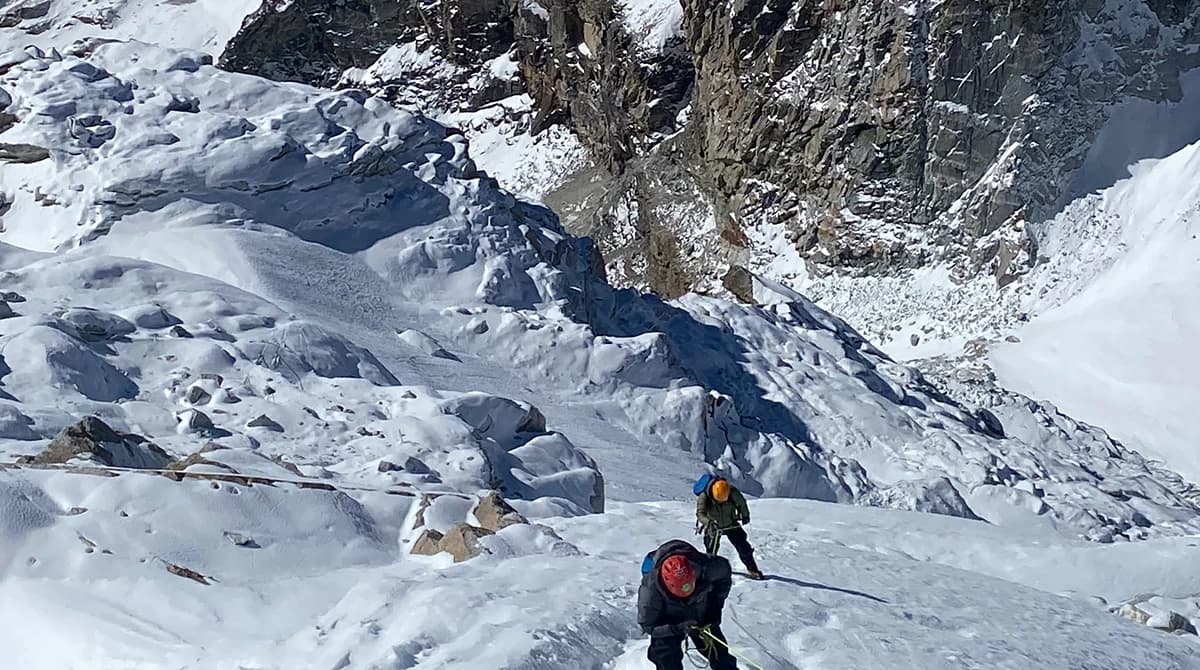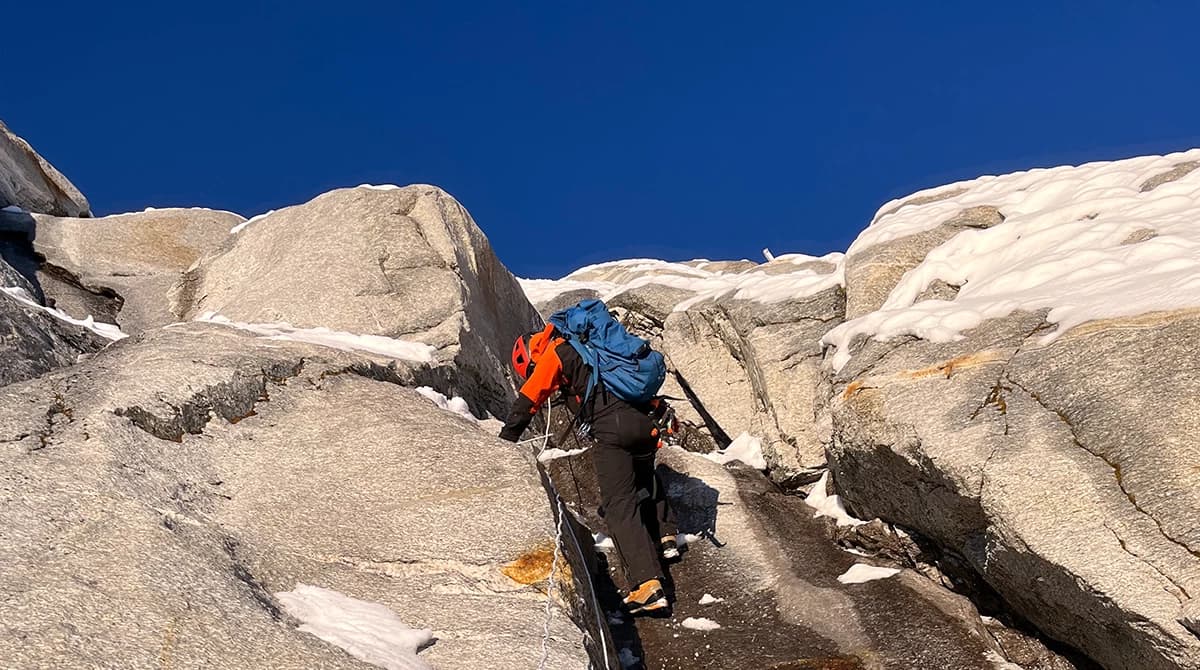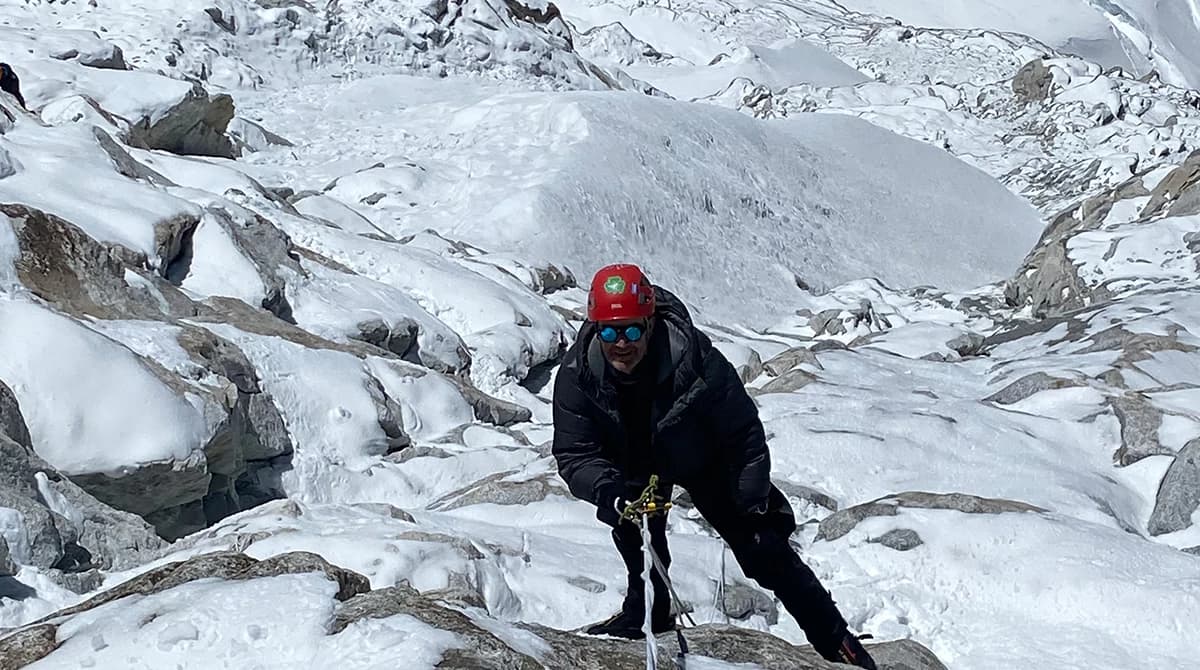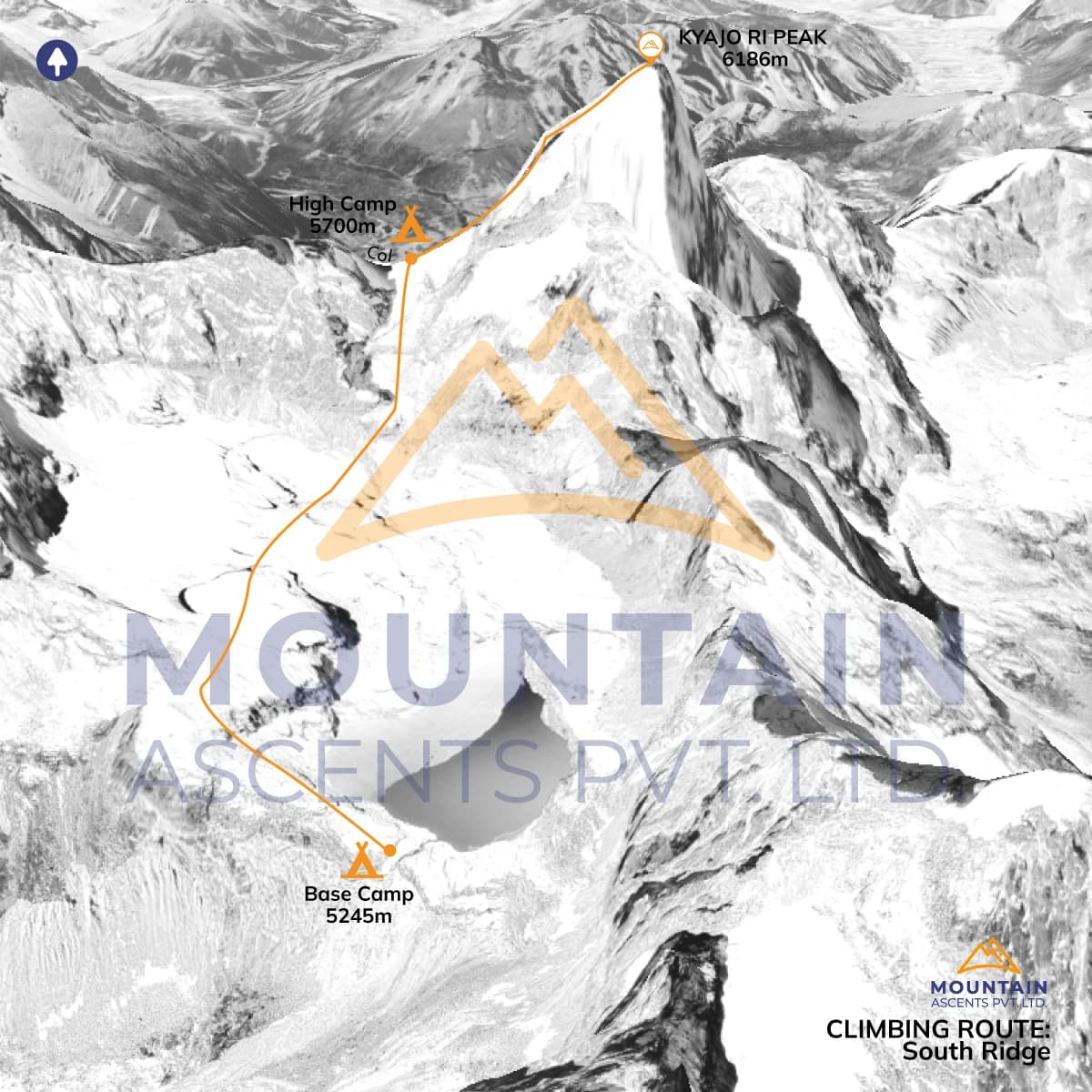Kyajo Ri Peak climbing in the Everest/Khumbu region of Nepal is a unique exhilarating expedition to climb a 6,000-meter semi-technical peak, ideal for mountaineers seeking a challenging yet accessible and rewarding experience. Standing tall at an elevation of around 6,186m, the peak is located towards the north of Thame village, to the east above the village of Lunden, and southwest of the Gokyo Lake and is considered the highest point of the Khumbu Himal Range on the southern sides that extends north of Namche Bazaar.
Opened for tourists only in 2002, the Kyajo Ri is famous for its stunning vistas of the surrounding Himalayan giants such as Lhotse, Ama Dablam, and Makalu, including the highest mountain peak in the world, Mount Everest (8,848 m), and is the best alternative to some other more popular and crowded peak like Island Peak or Lobuche East. Hence, the peak is a must-summit for a more secluded experience without having to deal with massive crowds, rewarding one with a greater sense of raw Himalayan wilderness.
The expedition to Kyajo Ri, as with any other mountains in the Khumbu region, begins with a thrilling flight from Ramechhap to Lukla. After landing in Lukla, climbers make their way through the raging Dudh Koshi river until Namche and follow the central climb to Khumjung and ultimately to the base camp through a high mountain valley. Trekkers and climbers acclimate to the high altitude, traversing through alpine meadows, rhododendron forests, and traditional Sherpa settlements, combining the tranquil experience of trekking, climbing, and vibrant local culture in one single trip.
However, it is crucial to understand that though the trekking and climbing in both sections might be suitable even for first-timers with a good amount of physical fitness, the climb itself is physically demanding and is better done with some prior mountaineering expertise and training in the high altitude. Despite the technicalities of the mixed climb, Mountain Ascents, with our professional guides and crew, is dedicated to making this expedition a success and a lifelong memorable adventure for you.
Join us now for an excellent itinerary and the best prices for every trip you do, such as expeditions to Everest, Manaslu, Island, Himlung, and many others, including Kyajo Ri Climbing.
Trip Highlights
- Venture around the aromatic local markets, alleyways, and towns of the Kathmandu Valley and its UNESCO World Heritage Sites.
- Enjoy spectacular aerial views of the Himalayas, typical villages, and other natural beauty on a mountain flight to Lukla from Kathmandu and back.
- Get to be in the majestic presence of awe-inspiring Himalayan ranges such as Everest, Lhotse, Makalu, and others, especially from the Kyajo Ri Peak itself.
- Experience authentic Sherpa culture, tradition, and way of life firsthand.
- Trek through the naturally abundant Sagarmatha National Park of Nepal.
- Mark your victory at 6000 m + Kyajo Ri Peak.
- Engage in rock climbing, mountaineering skill development, steep alpine walks, and many more.
What makes climbing to Kyajo Ri Peak special?
Kyajo Ri climbing in the Khumbu Region of the Nepalese Himalayas is a thrilling adventure that offers a technical climb with fewer crowds and rewarding views of the Himalayan mountains and surrounding landscapes. Trekkers and climbers are expected to walk 5-7 hours a day in the high altitude sections, especially the summit journey to the Kyajo Ri from High Base Camp, involving steep slopes, rugged terrain, and alpine conditions in remote areas.
The Sherpa villages and ancient culture, cultural heritage, and the spiritual richness of the Khumbu Valley add much to this Himalayan expedition, further enhanced by the natural beauty and untouched wilderness of the Sagarmatha National Park, also recognized as Nepal’s one of the natural UNESCO World Heritage Sites. Among its numerous highlights here are some of the key features that make this Kyajo Ri Peak Climbing special:
Experience the remote and less traveled peak in the Everest Region
Though the Kyajo Ri Climb takes place in one of the most popular trekking regions of Nepal, the Everest Trekking Region in the Khumbu Valley, and typically begins with an incredibly scenic flight to Lukla and trek to Namche Bazaar through Phakding, the route there onwards diverges and climbs the less trodden peak of Kyajo Ri.
You will get to step off the massively populated paths of the Everest region into a remote and soul-stirring journey, allowing a more immersive connection to the natural surroundings and the true essence of a remote alpine environment with zero compromise in cultural experience. It will be warm to pass through traditional villages like Phakding, Namche Bazaar, and Khumjung in such remoteness, offering you hearty meals and accommodation. The locals are the friendly Sherpas, known for their extraordinary mountaineering skills and hospitality.
During the expedition’s trekking phase, these Himalayan locals welcome you with open arms in the tea houses and are delighted to share their culture, traditions, way of life, and stories of the Himalayas dip into Buddhism. Therefore, Kyajo Ri Climbing allows more authentic, quieter, and unforgettable adventures as an off-beaten path in the remote Himalayas of Nepal, far away from daily hassle.
Unparalleled Himalayan Views
During the Kyajo Ri Peak Climbing Journey that meticulously combines the thrill of alpine trekking and climbing, trekkers and climbers are rewarded with panoramic views of the surrounding peaks right from the beginning, including the mountain flight to Lukla. In the initial trek days from Lukla to Phakding and then to Namche Bazaar, Khumjung, you will get to relish the dynasty views of Mt. Everest, Lhotse, Makalu, Cho Oyu, Ama Dablam, Taboche, Cholatse, and many others.
The view gets more and more refined as the trek progresses and is especially unmatchable from the Kyajo Ri Base Camp, High Camp, and the Kyajo Ri Peak itself at an altitude of 6,186m above sea level. From the summit, adventurers are rewarded with astonishing 360-degree views of numerous iconic Himalayan peaks precisely early in the morning when the sun casts a golden and yellow shadow over the awe-inspiring snow-capped mountain giants.
An opportunity to appreciate the biodiversity of the Everest Region
As you can guess, the Kyajo Ri Peak Summit journey is through one of the protected areas of the Himalayan country of Nepal, the Sagarmatha National Park, which is also home to the highest peak on the planet, Mt. Everest (8,848 m). Established in the year 1976 and encompassing an area of 1,148 square kilometers in the Solukhumbu district of Nepal, the site was later declared one of the UNESCO World Heritage Sites in January 2002.
The park area showcases the rich biodiversity of the Everest region as you journey through the lower lush valleys, dense rhododendron, oak, and juniper forests to high alpine land with only sparse vegetation and barren lands. On your lucky day, you can even get to catch sight of elusive Himalayan species of musk deer, blue sheep, Himalayan tahr, and a wide variety of birds, such as the vibrant Himalayan monal (Danfe), the national bird of Nepal.
Future, the expedition route to Kyajo Ri Peak is relatively isolated; the trip hence is going to be extremely inspirational, allowing more intimate and peaceful encounters with the natural diversity, a haven for nature lovers and photographers, which is an equally enriching experience for trekkers and climbers.
Challenging and Technical Climb with Diverse Terrain
The climb to Kyajo Ri requires navigation through sections of rock, ice, and mixed climbing, necessitating the acquisition of basic climbing skills. From advanced Base Camp, also called High Camp, at an altitude of 5700 m / 18,700 ft, the trail to the summit is characterized by snow ridges, mixed terrain, and scaling steep slopes.
You might have to use fixed ropes, crampons, and ice axes for more secure passages in the exposed areas, icy slopes, narrow ridges, and snow-covered pitches; hence, the peak is considered slightly more technically challenging than many of the other trekking peaks in Nepal, granting you an immense sense of adventure, achievement, and camaraderie with a successful ascent.
Therefore, the Kyajo Ri Peak is one of the ideal technical practice mountain ranges to use for preparation for higher altitude and more demanding peaks to strengthen climbing skills without stepping into the real of 8,000 m.
A perfect combination of tea house and camping experience
The Kyajo Ri Climbing Journey begins along the well-traversed trails through the Khumbu Region of Nepal, featuring cozy tea houses and lodges nestled in Sherpa villages such as Phakding, Namche Bazaar, and Khumjung. These tea houses provide trekkers, climbers, visitors, and travelers warm meals, comfortable beds, and a chance to experience the local Himalayan culture.
You will get to learn about the traditional Sherpa life and enjoy the social and spiritual atmosphere of the Everest/Khumbu region with fellow adventurers, which converts into camping and the solitude that comes with it on the way to the summit from the Kyajo Ri’s Base Camp.
The experience is raw and perfect for stargazing, accompanied by snowcapped views of the surrounding mountain giants, marking your closeness to nature and unobstructed connection to the stunning landscapes and glacial areas. Hence, the Kyajo Ri climbing offers the must to enjoy both teahouse and camping-style mountain experiences in the Nepalese Himalayas.
Why the 18-day itinerary for Kyajo Ri Climbing is the best route?
The 18-day Kyajo Ri Climbing itinerary begins with your arrival at the terminal gate of the Tribhuvan International Airport (TIA), a visit to several UNESCO World Heritage Sites in the Kathmandu Valley, and an alpine flight to the gateway to the Everest Region of Nepal, Lukla. From Lukla begins the trekking journey that proceeds along the Dudkh Koshi River through beautiful dense forests of oak, pine, juniper, and rhododendron, passing by typical Himalayan dwellings of the Sherpa people.
After acclimatizing in Namche Bazaar, you will follow one of the less-trodden Everest Himalayan routes from there to the classic Everest Base Camp expedition, which is a gentle ascend all the way to Kyajo Ri Base Camp via the stunning traditional town of Khumjung. Nonetheless, once reaching the base camp, you will engage yourself in altitude acclimatization, training, and climbing practice with at least one whole day allocated for it: one day in base camp, one in lake camp, and then in high camp.
From High Camp, you will ascend to Kyajo Ri Peak, spend some time there, and return to base camp. The journey thereafter is mostly descending to get back to Kathmandu, traversing the same route, ensuring sufficient time for acclimatization, cultural exploration, and summit preparation for technical training and climbing all in 18 days; hence, it is considered the best itinerary and route for the Kyajo Ri Climbing.
Further at Mountain Ascents, you can customize the Kyajo Ri Climbing Itinerary as per your needs and preferences, where it is advised to add some extra days rather than deduct for a better immersive and enhanced experience that is likely to be hassling without support for local guides, porters, and organizers like us with years of expertise in the Himalayas.
The 18-Day Kyajo Ri Peak Climbing Cost
Although the total package cost for Kyajo Ri Peak can vary significantly based on personal spending habits, travel insurance, and other inclusions, it is good to budget from USD 3,000 to USD 4,500 per person.
Generally, the overall price is determined by the total group size, the season you are climbing, the specific company you choose, and others. We at Mountain Ascents promise you the best competitive package cost that generally covers expenses for the majority of the basic necessities for a comprehensive trekking and climbing experience.



